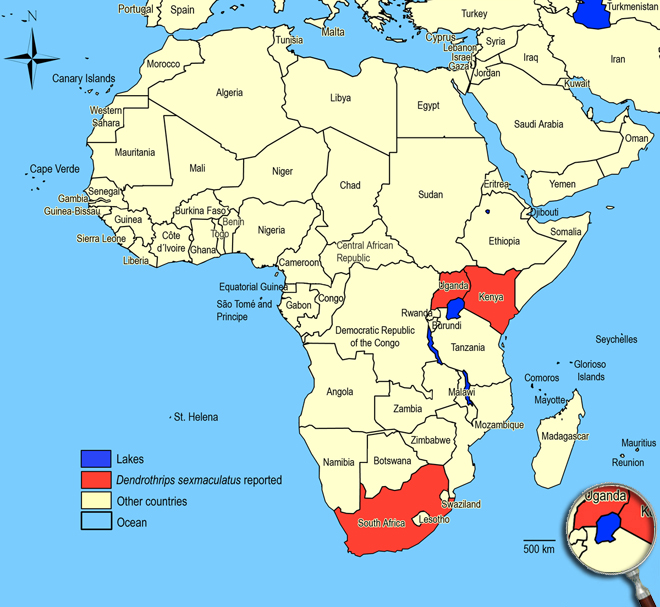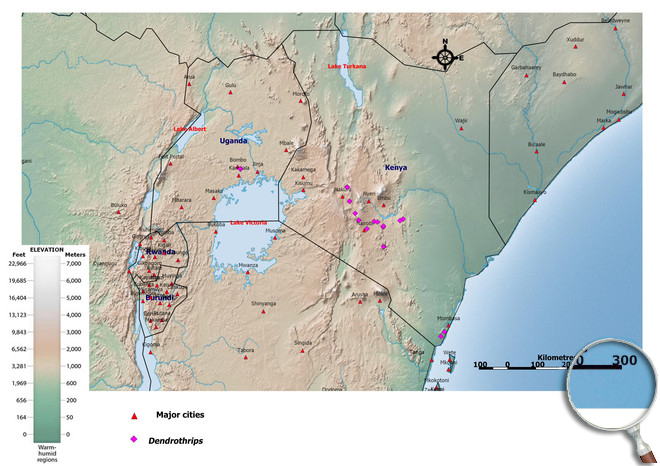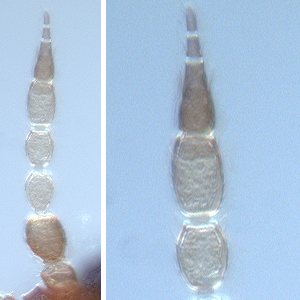Dendrothrips sexmaculatus Bagnall, 1916
Dendrothripinae, Thripidae, Terebrantia, Thysanoptera
Figures
Fig. 1: 8-segmented antenna, terminal segments V-VIII
Fig. 2: Head dorsal with ocellar triangle
Fig. 3: Pronotum
Fig. 4: Meso- and metanotum
Fig. 5: Fore- and hind wing, fore wing anterior margin
Fig. 6: Meso- and metasternum with lyre-shaped furca
Fig. 7: Head and thorax
Fig. 8: Tergites IV-VIII
Fig. 9: Tergite VIII with posteromarginal comb and tergite IX
Introduction and recognition
Dendrothrips sexmaculatus breeds on leaves of woody plants like kei-apple (Dovyalis caffra) and wild peach (Kiggelaria sp.). Both sexes fully winged. Head and thorax brown (Fig. 2 and 3); abdomen bicolored, with segment 3 posteriorly and 4-6 yellow (Fig. 8), each with a pair of dark brown spots, other segements brown; fore wings dark grey with basal one-fifth pale (Fig. 5); all tarsi yellow; antennae brown, segments III and IV yellowish (Fig. 1). Antennae 8-segmented; segments III & IV with slender forked sensorium. Head wider than long (Fig. 2), reticulate between ocelli; 2 pairs of ocellar setae, ocellar setae pair III outside ocellar triangle in front of posterior ocelli, ocellar setae I absent. Pronotum reticulate, reticles with internal markings; discal setae minute; posterior margin with no long setae (Fig. 3). Mesofurca with median spinula. Metanotum with elongate reticulation (Fig. 4); median pair of setae small and arising well behind anterior margin, campaniform sensilla absent; metathoracic furca lyre-shaped (Fig. 6), extending into mesothorax. Tarsi 2-segmented. Fore wing with no prominent setae; wing apex recurved with no prominent terminal seta; anteromarginal cilia arising ventrally far behind anterior margin (Fig. 5), fore wing first vein distinct from costal vein. Tergites with median pair of setae longer than distance between their bases (Fig. 8); lateral thirds of tergites with complex sculpture; posterior margin of VIII with complete comb of short and irregular microtrichia (Fig. 9); tergite X with no longitudinal split. Sternites with 3 pairs of short marginal setae, median pair on VII arising at margin.
Male similar to female.
Taxonomic identity
Species
Dendrothrips sexmaculatus Bagnall, 1916
Taxonomic history
-
Common name
-
Present taxonomic position
Family: Thripidae Stephens, 1829
Subfamily: Dendrothripinae Priesner, 1925
Genus: Dendrothrips Uzel, 1895
Genus description
The genus Dendrothrips Uzel, 1895
The Old World genus Dendrothrips currently includes more than 50 described species, mainly from Africa, Asia, Australia and Europe (zur Strassen 2003). The metathoracic endofurca is greatly enlarged, "lyre-shaped" as in other members of the Dendrothripinae (Mound 1999), extending into the mesothorax, the sides of the metathorax are greatly swollen, the hind coxae are wider than long, the fore wing cilia arise ventrally well behind the anterior margin, and the apex of the fore wing is recurved without a prominent terminal seta. The form of the wing apex distinguishes the members of this genus from the other species placed in the Dendrothripinae. All of them jump actively, and usually can be found on plants with small hard leaves, such as Oleaceae shrubs and trees (Mound & Kibby 1998).
Species description
Typical key character states of Dendrothrips sexmaculatus
Coloration and body sculpture
Body color: distinctively bicolored
Surface of head, pronotum and fore legs: without obvious or with weakly reticulate sculpture
Antennae
Number of antennal segments: 8
Form of sense cones on antennal segments III and IV: emergent and forked on segments III and IV
Forked sense cone on antennal segment IV: scarcely extending beyond base of segment V
Head
Distance between bases of ocellar setae III: greater than width of first ocellus
Head: not prolonged in front of compound eyes
Ocellar setae I: absent
Ocellar setae III: arising on anterior margin of, or in front of ocellar triangle
Ocelli: present
Prothorax
Pronotal blotch or internal apodeme: absent
Pronotum shape: broadly rectangular
Mesothorax
Mesosternal furca: with median spinula
Metathorax
Metanotal campaniform sensilla: absent
Metanotal median setae: S1 behind anterior margin
Metanotum with dominant sculptured triangle medially: absent
Shape of metathoracic furca: elongate and lyre-shaped
Wings
Fore and hind wings: present, more than half as long as abdomen (macropterous)
Fore- and hind wing surface: covered with microtrichia
Fringe cilia arising: from sockets
Fore wing costal fringe cilia: arising ventrally behind anterior margin
Fore wing veins: present
Apex of fore wing: without prominent terminal setae
Fore wing anterior margin (costal vein): with cilia but minute setae or without setae
Fore wing first vein: distinct from costal vein
Fore wing shape: mainly parallel sided or margins run continuously towards each other
Shape of fore wing apex: with mainly anterior margin curved to join posterior margin
Fore wing surface: not reticulate
Length of fore wing costal setae at middle of wing: minute or shorter than half of median wing width
Fore wings: uniformly dark or shaded, but with base or sub-base pale
Fore wing extreme apex color: dark
Legs
Mid and hind tarsi: with one segment
Color of fore tarsi: pale or yellow, sometimes apically shaded or brown
Abdomen
Tergite X: not tubular, longitudinally incomplete
Sternite VII median posteromarginal setae S1: arising at posterior margin
Tergites IV and V median setal pair: longer than distance between their bases
Tergite VIII posteromarginal comb of microtrichia: present and complete medially
Tergite VIII shape of posteromarginal microtrichia: short and irregular in length

Similar or related species
Compared to other species of the family Thripidae, member of the genus Dendrothrips have an elongate and lyre-shape metathoracic endofurca, and the fore wing cilia arise ventrally well behind the anterior margin. Dendrothrips sexmaculatus differs from other Dendrothrips species in the transverse pale band across the abdomen (Mound 1968) and the dark grey fore wings with a basal pale area.
Biology
Life history
As with other thrips species the life cycle from egg to adult is dependent on temperature. The full cycle can take less than one week to over a month and adults may live for more than one month producing several generations in one year depending on seasonal weather (Lewis 1973).
Host plants
Kei-apple (Dovyalis caffra), wild peach (Kiggelaria sp.).
Vector capacity
None identified, but possible mechanical distribution of phytopathogenic fungi and bacteria.
Damage and symptoms
Leaf feeding creates silvering, speckling, leaves pucker and shed. Adults are usually found on the upper side of the leaves.
Detection and control strategies
-
Additional notes
-
Biogeography
Sri Lanka, South Africa.
African countries where Dendrothrips sexmaculatus has been reported

Occurence of Dendrothrips sexmaculatus in East Africa

Please click here for survey sites of all observed thrips species of Kenya, Tanzania and Uganda.
Click here for locations of Dendrothrips species in parts of East Africa.

Bibliography
Bagnall RS (1916). Brief descriptions of new Thysanoptera - VIII. Annals and Magazine of Natural History, Zoology, Botany and Geology. (Serie 8) 17: 397-412
Bhatti JS (2006). The classification of Terebrantia (Insecta) into families. Oriental Insects. 40 (1): 339-375
Faure JC (1960). Thysanoptera of Africa - 4. Journal of the Entomological Society of Southern Africa. 23 (2): 237-277
Lewis T (1973). Thrips: their biology, ecology and economic importance. Academic Press Inc., London Ltd., 349 pp
Moritz G (2006). Thripse. Pflanzensaftsaugende Insekten, Bd. 1, (1. Auflage). Westarp, Hohenwarsleben, 384 pp. ISBN-13: 978 3 89432 891 7
Mound LA (1968). A review of R. S. Bagnalľs Thysanoptera collections. Bulletin of the British Museum (Natural History), Entomology. Supplement 11: 1-181
Mound LA (1999). Saltatorial leaf-feeding Thysanoptera (Thripidae: Dendrothripinae) from Australia and New Caledonia, with newly recorded pests of ferns, figs and mulberries. Australian Journal of Entomology. 38 (4): 257-273
Mound LA & Kibby G (1998). Thysanoptera: An identification guide, (2nd edition). CAB International, Wallingford and New York, 70 pp
zur Strassen R (1968). Tabellarische Arten-Übersicht der Fransenflügler-Gattung Dendrothrips Uzel 1895 (Thysanoptera: Thripidae). Journal of the Entomological Society of Southern Africa. 31 (1): 213-220
zur Strassen R (2003). Die terebranten Thysanopteren Europas und des Mittelmeer-Gebietes. Die Tierwelt Deutschlands und der angrenzenden Meeresteile nach ihren Merkmalen und nach ihrer Lebensweise, 74. Teil. Goecke & Evers, Keltern, Germany, 277 pp
----
Web links
Mound´s Thysanoptera pages
Thysanoptera Checklist
ICIPE Thrips survey sites
UNI Halle & Thrips sites
Thrips of California













